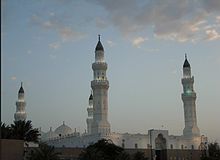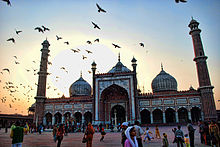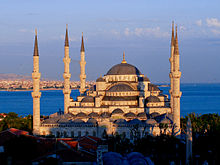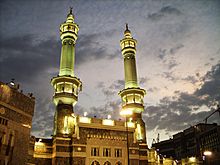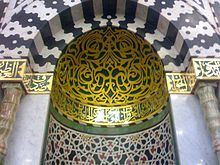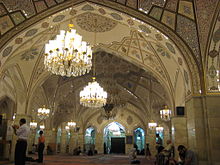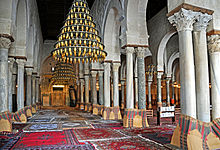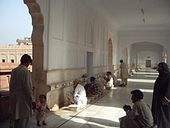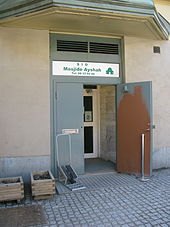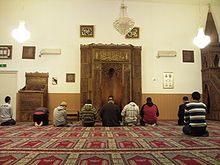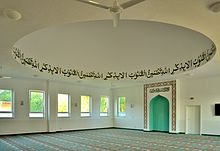
Mosque
Background Information
SOS believes education gives a better chance in life to children in the developing world too. Before you decide about sponsoring a child, why not learn about different sponsorship charities first?
A mosque ( / m ɒ s k /; Arabic:مسجد masjid pl. مساجد masājid), sometimes spelt mosk, is a place of worship for followers of Islam. The word entered English from a French word which probably derived from Italian moschea, a variant of Italian moscheta, from either Armenian մզկիթ (mzkiṭ) or Greek μασγίδιον (masgídion) or Spanish mesquita, from Arabic مسجد (masjid), meaning "place of worship" or "prostration in prayer", either from Nabataean masgĕdhā́ or from Arabic سجد (sajada), meaning "to bow down in prayer" or "worship", probably ultimately from Aramaic sĕghēdh.
There are strict and detailed requirements in Sunni fiqh for a place of worship to be considered a masjid, with places that do not meet these requirements regarded as musallas. There are stringent restrictions on the uses of the area formally demarcated as the masjid (which is often a small portion of the larger complex), and, in the Sharia, after an area is formally designated as a masjid, it remains so until the Last Day.
Quba Mosque is the first mosque in history, and mosques have developed significantly since Quba mosque. Many mosques have elaborate domes, minarets, and prayer halls. Mosques originated on the Arabian Peninsula, but are now found in all inhabited continents. The mosque serves as a place where Muslims can come together for salah (prayer) (Arabic: صلاة, ṣalāt) as well as a centre for information, education, and dispute settlement. The imam leads the prayer.
History
Grand entryways and tall towers, or minarets, have long been and continue to be closely associated with mosques. However, the first three masajid were very simple open spaces on the Arabian Peninsula. Mosques evolved significantly over the next 1,000 years, acquiring their now-distinctive features and adapting to cultures around the world.
Diffusion and evolution
Mosques were built outside the Arabian Peninsula as Muslims moved to other parts of the world. Egypt became occupied by Muslim Arabs as early as 640, and since then so many mosques have appeared throughout the country that its capital city, Cairo, has acquired the nickname of city of a thousand minarets. Egyptian mosques vary in amenities, as some have Islamic schools ( madrasahs) while others have hospitals or tombs. Built soon after the conquest of northwest Africa, the first mosque built in this region is the Great Mosque of Kairouan (in Tunisia) founded by the Umayyad general Uqba Ibn Nafi during the second half of the 7th century and considered as the oldest place of worship in the western Islamic world. The Great Mosque of Kairouan, which is one of the most significant and best preserved examples of early Islamic mosques, served due to its architectural characteristics as a model to many later mosques especially in north Africa and Al-Andalus. Mosques in Sicily and Spain do not primarily reflect the architecture of Visigothic predecessors, but instead reflect the architecture introduced by the Muslim Moors. It is hypothesized, however, that there were some elements of pre-Islamic architecture which were Islamicized into Andalusi and Maghribi architecture, for example, the distinctive horseshoe arch.


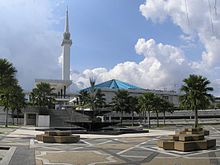
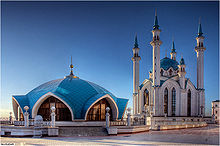
The first Chinese mosque was established in the 8th century in Xi'an. The Great Mosque of Xi'an, whose current building dates from the 18th century, does not replicate many of the features often associated with traditional mosques. Instead, it follows traditional Chinese architecture. It is distinguished from other buildings by its green roof ( Buddhist temples are often built with a yellow roof). Mosques in western China incorporate more traditional elements seen in mosques in other parts of the world. Western Chinese mosques were more likely to incorporate minarets and domes while eastern Chinese mosques were more likely to look like pagodas.
By the 15th century, Islam had become the dominant religion in Java and Sumatra, Indonesia's two most populous islands. As with Hinduism and Buddhism before it, the new religion and its accompanying foreign influences were absorbed and reinterpreted, with mosques given a unique Indonesian/Javanese interpretation. At the time, Javanese mosques took many design cues from Hindu, Buddhist, and even Chinese architectural influences. They lacked, for example, the ubiquitous Islamic dome which did not appear in Indonesia until the 19th century, but had tall timber, multi-level roofs not too dissimilar to the pagodas of Balinese Hindu temples still common today. A number of significant early mosques survive, particularly along the north coast of Java. These include the Mesjid Agung back in Demak, built in 1474, and the Grand Mosque of Yogyakarta that feature multi-level roofs. Javanese styles in turn influenced the architectural styles of mosques among Indonesia's Austronesian neighbors: Malaysia, Brunei and the southern Philippines.
In India, the first mosque has been claimed as Cheraman Juma Masjid in the early 7th century, but this claim is dubious. They diffused into a majority of India only during the reign of the Mughal Empire in the 16th and 17th centuries. The Mughals brought their own form of architecture that included pointed, onion-shaped domes, as seen in Delhi's Jama Masjid. Mughal style became the dominant feature in many of the old mosques in India, Pakistan and Bangladesh.
Mosques first arrived in the Ottoman Empire (mostly present-day Turkey) during the 11th century, when many local Turks converted to Islam. Several of the first mosques in the Ottoman Empire, such as the Hagia Sophia in present-day Istanbul, were originally churches or cathedrals in the Byzantine Empire. The Ottomans created their own design of mosques, which included large central domes, multiple minarets, and open facades. The Ottoman style of mosque usually included elaborate columns, aisles, and high ceilings in the interior, while incorporating traditional elements, such as the mihrab. Today, Turkey is still home to many mosques that display this Ottoman style of architecture.
Mosques gradually diffused to different parts of Europe, but the most rapid growth in the number of mosques has occurred within the past century as more Muslims have migrated to the continent. Major European cities, such as Rome, London, and Munich, are home to mosques that feature traditional domes and minarets. These large mosques in urban centers are supposed to serve as community and social centers for a large group of Muslims that occupy the region. However, one can still find smaller mosques in more suburban and rural regions throughout Europe where Muslims populate, an example of this is the Shah Jahan Mosque in Woking, the first purpose built mosque in the UK.
Mosques first appeared in the United States in the early 20th century, the likely first being one in Maine built by Albanian immigrants in 1915. as more immigrants continue to arrive in the country, especially from South Asia, the number of American mosques is increasing faster than ever before. Whereas only two percent of the country's mosques appeared in the United States before 1950, eighty-seven percent of American mosques were founded after 1970 and fifty percent of American mosques founded after 1980.
Conversion of places of worship

According to early Muslim historians, towns that surrendered without resistance and made treaties with the Muslims gave the Muslims permission to take their churches and synagogues. One of the earliest examples of these kinds of conversions was in Damascus, Syria, where in 705 Umayyad caliph Al-Walid I bought the church of St. John from the Christians and had it rebuilt as a mosque in exchange for building a number of new churches for the Christians in Damascus. Overall, Abd al-Malik ibn Marwan (Al-Waleed's father) is said to have transformed 10 churches in Damascus into mosques.
The process of turning churches into mosques was especially intensive in the villages where most of the inhabitants converted to Islam. The Abbasid caliph al-Ma'mun turned many churches into mosques. Ottoman Turks converted nearly all churches, monasteries, and chapels in Constantinople, including the famous Hagia Sophia, immediately after capturing the city in 1453 into mosques. In some instances mosques have been established on the places of Jewish or Christian sanctuaries associated with Biblical personalities who were also recognized by Islam.
Mosques have also been converted for use by other religions, notably in southern Spain, following the conquest of the Moors in 1492. The most prominent of them is the Great Mosque of Cordoba. The Iberian Peninsula and southeast Europe are other regions in the world where such instances occurred once no longer under Muslim rule.
Religious functions
The masjid jāmi', a central mosque, can play a role in religious activities such as teaching the Quran and educating future imams.
Prayers
There are two holidays (Eids) in the Islamic calendar, Eid ul-Fitr and Eid al-Adha during which there are special prayers held at mosques in the morning. These Eid prayers are supposed to be offered in large groups, and so, in the absence of an outdoor eidgah larger mosques will normally host them for their congregants as well as the congregants of smaller local mosques. Some mosques will even rent convention centers or other large public buildings to hold the large number of Muslims who attend. Mosques, especially those in countries where Muslims are the majority, will also host Eid prayers outside in courtyards, town squares or on the outskirts of town in an Eidgah.
Ramadan events
Islam's holiest month, Ramadan, is observed through many events. As Muslims must fast during the day during Ramadan, mosques will host iftar dinners after sunset and the fourth required prayer of the day, maghrib. Food is provided, at least in part, by members of the community, thereby creating nightly potluck dinners. Because of the community contribution necessary to serve iftar dinners, mosques with smaller congregations may not be able to host the iftar dinners daily. Some mosques will also hold suhoor meals before dawn to congregants attending the first required prayer of the day, fajr. As with iftar dinners, congregants usually provide the food for suhoor, although able mosques may provide food instead. Mosques will often invite poorer members of the Muslim community to share in beginning and breaking the fasts, as providing charity during Ramadan is regarded in Islam as especially honorable.
Following the last obligatory daily prayer ( Isha') special, optional tarawih prayers are offered in larger mosques. During each night of prayers, which can last for up to two hours each night, usually one member of the community who has memorized the entire Quran (a Hafiz) will recite a segment of the book. Sometimes, several such people (not necessarily of the local community) take turns to do this. During the last ten days of Ramadan, larger mosques will host all-night programs to observe Laylat al-Qadr, the night Muslims believe that Muhammad first received Quranic revelations. On that night, between sunset and sunrise, mosques employ speakers to educate congregants in attendance about Islam. Mosques or the community usually provide meals periodically throughout the night.
During the last ten days of Ramadan, larger mosques within the Muslim community will host Iʿtikāf, a practice in which at least one Muslim man from the community must participate. Muslims performing itikaf are required to stay within the mosque for ten consecutive days, often in worship or learning about Islam. As a result, the rest of the Muslim community is responsible for providing the participants with food, drinks, and whatever else they need during their stay.
Charity
The third of the Five Pillars of Islam states that Muslims are required to give approximately one-fortieth of their wealth to charity as zakat. Since mosques form the centre of Muslim communities, they are where Muslims go to both give zakat and, if necessary, collect it. Prior to the holiday of Eid ul-Fitr, mosques also collect a special zakat that is supposed to assist in helping poor Muslims attend the prayers and celebrations associated with the holiday.
Contemporary political roles
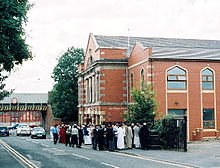
The late 20th century saw an increase in the number of mosques used for political purposes. Today, civic participation is commonly promoted in mosques in the Western world. Because of the importance in the community, mosques are used for preaching peaceful coexistence with non-believers, even in times of adversity.
Large mosques sometimes play a political role as well. In Islamic countries like Pakistan, Iran, and Iraq (after 2003), political subjects are preached by imams at Friday congregations on a regular basis. In other Islamic countries, imams are usually banned from mentioning political issues.
Advocacy
Countries with a minority Muslim population are more likely than Muslim-majority countries of the Greater Middle East to use mosques as a way to promote civic participation. American mosques host voter registration and civic participation drives that promote involving Muslims, who are often first- or second-generation immigrants, in the political process. As a result of these efforts as well as attempts at mosques to keep Muslims informed about the issues facing the Muslim community, regular mosque attendants are more likely to participate in protests, sign petitions, and otherwise be involved in politics.
Nevertheless, a link between political views and mosque attendance can still be seen in other parts of the world. Following the al-Askari Mosque bombing in February 2006, imams and other Islamic leaders used mosques and Friday prayers as vehicles to call for calm and peace in the midst of widespread violence.
Social conflict
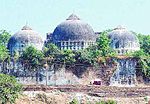
As they are considered important to the Muslim community, mosques, like other places of worship, can be at the heart of social conflicts. The Babri Mosque was the subject of such a conflict up until the early 1990s when it was demolished. Before a mutual solution could be devised, the mosque was destroyed on December 6, 1992 as the mosque was built by Babur allegedly on the site of a previous Hindu temple marking the birthplace of Rama. The controversy surrounded the mosque was directly linked to rioting in Bombay (present-day Mumbai) as well as bombings in 1993 that killed 257 people.
A February 2006 and June 2007 bombing that seriously damaged Iraq's al-Askari Mosque, exacerbated tensions that had already existed. Other mosque bombings in Iraq, both before and after the February 2006 bombing, have been part of the conflict between the country's groups of Muslims. However, mosque bombings have not been exclusive to Iraq; in June 2005, a suicide bomber killed at least 19 people at an Afghan Shia mosque near Jade Maivand. In April 2006, two explosions occurred at India's Jama Masjid.
Following the September 11 attacks, several American mosques were targeted in attacks ranging from simple vandalism to arson. Furthermore, the Jewish Defense League was suspected of plotting to bomb the King Fahd Mosque in Culver City, California. Similar attacks occurred throughout the United Kingdom following the 7 July 2005 London bombings. Outside the Western world, in June 2001, the Hassan Bek Mosque was the target of vandalism and attacks by hundreds of Israelis.
Saudi influence

Although the Saudi involvement in mosques around the world can be traced back to the 1960s, it was not until later in the 20th century that the government of Saudi Arabia became a large influence in foreign mosques. Beginning in the 1980s, the Saudi Arabian government began to finance the construction of mosques in countries around the world. An estimated US$45 billion has been spent by the Saudi Arabian government financing mosques and Islamic schools in foreign countries. Ain al-Yaqeen, a Saudi newspaper, reported in 2002 that Saudi funds may have contributed to building as many as 1,500 mosques and 2,000 other Islamic centers.
Saudi citizens have also contributed significantly to mosques in the Islamic world, especially in countries where they see Muslims as poor and oppressed. Following the fall of the Soviet Union, in 1992, mosques in war-torn Afghanistan saw many contributions from Saudi citizens. The King Fahd Mosque in Culver City, California and the Islamic Cultural Centre of Italy in Rome represent two of Saudi Arabia's largest investments in foreign mosques as former Saudi king Fahd bin Abdul Aziz al-Saud contributed US$8 million and US$50 million to the two mosques, respectively.
Architecture
Styles
Arab-plan or hypostyle mosques are the earliest type of mosques, pioneered under the Umayyad Dynasty. These mosques have square or rectangular plans with an enclosed courtyard and covered prayer hall. Historically, in the warm Middle Eastern and Mediterranean climates, the courtyard served to accommodate the large number of worshippers during Friday prayers. Most early hypostyle mosques had flat roofs on prayer halls, which required the use of numerous columns and supports. One of the most notable hypostyle mosques is the Great Mosque of Cordoba in Spain, the building being supported by over 850 columns. Frequently, hypostyle mosques have outer arcades so that visitors can enjoy the shade. Arab-plan mosques were constructed mostly under the Umayyad and Abbasid dynasties; subsequently, however, the simplicity of the Arab plan limited the opportunities for further development, the mosques consequently losing popularity.
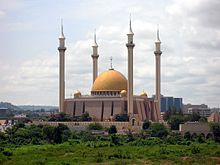
The first separate brand within mosque designs started appearing in Persia (Iran). The Persians had inherited a rich architectural legacy from the earlier Persian dynasties, and they started incorporating elements from earlier Parthian and Sassanid palace-designs into their mosques, influenced by buildings such as the Palace of Ardashir and the Sarvestan Palace. Thus, Islamic architecture started witnessing the introduction of such structures as domes and large, arched entrances, referred to as iwans. During Seljuq rule, as Islamic mysticism was on the rise, the four-iwan arrangement took form. The four-iwan format, finalized by the Seljuqs, and later inherited by the Safavids, firmly established the courtyard facade of such mosques, with the towering gateways at every side, as more important than the actual buildings themselves, and they typically took the form of a square-shaped, central courtyard with large entrances at each side, giving the impression of being gateways to the spiritual world. Soon, a distinctly Persian style of mosques started appearing that would significantly influence the designs of later Timurid, and also Mughal, mosque designs.
The Ottomans introduced central dome mosques in the 15th century. These mosques have a large dome centered over the prayer hall. In addition to having a large central dome, a common feature is smaller domes that exist off-centre over the prayer hall or throughout the rest of the mosque, where prayer is not performed. This style was heavily influenced by Byzantine religious architecture with its use of large central domes. Hajja Soad's mosque took a pyramid shape which is a creative style in Islamic architecture.
The Faisal Mosque in Islamabad, Pakistan in a relatively unusual design fuses contemporary lines with the more traditional look of an Arab Bedouin's tent, with its large triangular prayer hall and four minarets. However, unlike traditional mosque design, it lacks a dome. The mosque's architecture is a departure from the long history of South Asian Islamic architecture. It is one of the most outstanding and modern Islamic architecture examples in the world.
Mosques built in Southeast Asia often represent the Indonesian-Javanese style architecture, which are different from the ones found throughout the Greater Middle East. The ones found in Europe and North America appear to have various styles but most are built on Western artchitectural designs, some are former churches or other buildings that were used by non-Muslims. In Africa, most mosques are old but the new ones are built to give it a look of the Greater Middle East. This can be seen in the Abuja National Mosque in Nigeria and others.
Minarets
A common feature in mosques is the minaret, the tall, slender tower that usually is situated at one of the corners of the mosque structure. The top of the minaret is always the highest point in mosques that have one, and often the highest point in the immediate area. The tallest minaret in the world is located at the Hassan II Mosque in Casablanca, Morocco.
The first mosques had no minarets, and even nowadays the most conservative Islamic movements, like Wahhabis, avoid building minarets, seeing them as ostentatious and hazardous in case of collapse. The first minaret was constructed in 665 in Basra during the reign of the Umayyad caliph Muawiyah I. Muawiyah encouraged the construction of minarets, as they were supposed to bring mosques on par with Christian churches with their bell towers. Consequently, mosque architects borrowed the shape of the bell tower for their minarets, which were used for essentially the same purpose — calling the faithful to prayer. The oldest standing minaret in the world is the minaret of the Great Mosque of Kairouan in Tunisia, built between the 8th and the 9th century, it is a massive square tower consisting of three superimposed tiers of gradual size and decor.
Before the five required daily prayers, a muezzin calls the worshippers to prayer from the minaret. In many countries like Singapore where Muslims are not the majority, mosques are prohibited from loudly broadcasting the call to prayer ( adhan), although it is supposed to be said loudly to the surrounding community. The adhan is required before every prayer. However, nearly every mosque assigns a muezzin for each prayer to say the adhan as it is a recommended practice or sunnah of the Islamic prophet Muhammad. At mosques that do not have minarets, the adhan is called instead from inside the mosque or somewhere else on the ground. The iqama, which is similar to the adhan and said immediately before the start of prayer, is usually not said from the minaret even if a mosque has one.
Mihrab
Mihrab is semicircular niche in the wall of a mosque that indicates the qibla; that is, the direction of the Kaaba in Mecca and hence the direction that Muslims should face when praying. The wall in which a mihrab appears is thus the "qibla wall."
Mihrabs should not be confused with the minbar, which is the raised platform from which an Imam (leader of prayer) addresses the congregation.
Domes

The domes, often placed directly above the main prayer hall, may signify the vaults of heaven and the sky. As time progressed, domes grew, from occupying a small part of the roof near the mihrab to encompassing the whole roof above the prayer hall. Although domes normally took on the shape of a hemisphere, the Mughals in India popularized onion-shaped domes in South Asia. Some mosques have multiple, often smaller, domes in addition to the main large dome that resides at the centre.
Prayer hall
The prayer hall, also known as the musallah, rarely has furniture; chairs and pews are generally absent from the prayer hall so as to allow as many worshipers as possible to line the room. Some mosques have Islamic calligraphy and Quranic verses on the walls to assist worshippers in focusing on the beauty of Islam and its holiest book, the Quran, as well as for decoration.
Often, a limited part of the prayer hall is sanctified formally as a masjid in the sharia sense (although the term masjid is also used for the larger mosque complex as well). Once designated, there are onerous limitations on the use of this formally designated masjid, and it may not be used for any purpose other than worship; restrictions that do not necessarily apply to other areas of the mosque complex (although such uses may be restricted by the conditions of the waqf that owns the mosque).
In many mosques, especially the early congregational mosques, the prayer hall has the hypostyle form (the roof held up by a multitude of columns). One of the finest examples of the hypostyle-plan mosques is the Great Mosque of Kairouan (also known as the Mosque of Uqba) in Tunisia.
Usually opposite the entrance to the prayer hall is the qiblah wall, the visually emphasized area inside the prayer hall. The qiblah wall should, in a properly oriented mosque, be set perpendicular to a line leading to Mecca, the location of the Kaaba. Congregants pray in rows parallel to the qiblah wall and thus arrange themselves so they face Mecca. In the qiblah wall, usually at its centre, is the mihrab, a niche or depression indicating the direction of Mecca. Usually the mihrab is not occupied by furniture either. Sometimes, especially during Friday prayers, a raised minbar or pulpit is located to the side of the mihrab for a khatib or some other speaker to offer a sermon ( khutbah). The mihrab serves as the location where the imam leads the five daily prayers on a regular basis.
Ablution facilities
As ritual purification precedes all prayers, mosques often have ablution fountains or other facilities for washing in their entryways or courtyards. However, worshippers at much smaller mosques often have to use restrooms to perform their ablutions. In traditional mosques, this function is often elaborated into a freestanding building in the centre of a courtyard. This desire for cleanliness extends to the prayer halls where shoes are disallowed to be worn anywhere other than the cloakroom. Thus, foyers with shelves to put shoes and racks to hold coats are commonplace among mosques.
Contemporary features
Modern mosques have a variety of amenities available to their congregants. As mosques are supposed to appeal to the community, they may also have additional facilities, from health clinics to libraries to gymnasiums, to serve the community.
Makeshift and temporary structures for Islamic worship
A temporary place set aside for Islamic worship is called a musalla (Jama'at Khana in South Asia). A musallah is often not part of a permanent endowment (waqf), or it is otherwise not intended to become a permanent legal masjid (as defined in the Sharia). Often musallas are used while a community looks for a piece of land for a permanent masjid, or the establishment of a masjid is not practical at the time. They could be located in rented apartments, industrial units or store fronts.
Rules and etiquette
Mosques, in accordance with Islamic practices, institute a number of rules intended to keep Muslims focused on worshipping God. While there are several rules, such as those regarding not allowing shoes in the prayer hall, that are universal, there are many other rules that are dealt with and enforced in a variety of ways from mosque to mosque.
Prayer leader
Appointment of a prayer leader is considered desirable, but not always obligatory. The permanent prayer leader (imam) must be a free honest individual and is authoritative in religious matters. In mosques constructed and maintained by the government, the prayer leader is appointed by the ruler; in private mosques, however, appointment is made by members of the congregation through majority voting. According to the Hanafi school of Islamic jurisprudence, the individual who built the mosque has a stronger claim to the title of imam, but this view is not shared by the other schools.
Leadership at prayer falls into three categories, depending on the type of prayer: five daily prayers, Friday prayer, or optional prayers. According to the Hanafi and Maliki school of Islamic jurisprudence, appointment of a prayer leader for Friday service is mandatory because otherwise the prayer is invalid. The Shafi'i and Hanbali schools, however, argue that the appointment is not necessary and the prayer is valid as long as it is performed in a congregation. A slave may lead a Friday prayer, but Muslim authorities disagree over whether the job can be done by a minor. An imam appointed to lead Friday prayers may also lead at the five daily prayers; Muslim scholars agree to the leader appointed for five daily services may lead the Friday service as well.
All Muslim authorities hold the consensus opinion that only men may lead prayer for men. Nevertheless women prayer leaders are allowed to lead prayer in front of all-female congregations.
Cleanliness
All mosques have rules regarding cleanliness, as it is an essential part of the worshippers' experience. Muslims before prayer are required to cleanse themselves in an ablution process known as wudu. However, even to those who enter the prayer hall of a mosque without the intention of praying, there are still rules that apply. Shoes must not be worn inside the carpeted prayer hall. Some mosques will also extend that rule to include other parts of the facility even if those other locations are not devoted to prayer. Congregants and visitors to mosques are supposed to be clean themselves. It is also undesirable to come to the mosque after eating something that smells, such as garlic.
Dress
Islam requires that its adherents wear clothes that portray modesty. As a result, although many mosques will not enforce violations, both men and women when attending a mosque must adhere to these guidelines. Men are supposed to come to the mosque wearing loose and clean clothes that do not reveal the shape of the body. Likewise, it is recommended that women at a mosque wear loose clothing that covers to the wrists and ankles, and cover their heads with a hijab or other covering. Many Muslims, regardless of their ethnic background, wear Middle Eastern clothing associated with Arabic Islam to special occasions and prayers at mosques.
Concentration
As mosques are places of worship, those within the mosque are required to remain respectful to those in prayer. Loud talking within the mosque, as well as discussion of topics deemed disrespectful, is forbidden in areas where people are praying. In addition, it is disrespectful to walk in front of or otherwise disturb Muslims in prayer. The walls within the mosque have few items, except for possibly Islamic calligraphy, so Muslims in prayer are not distracted. Muslims are also discouraged from wearing clothing with distracting images and symbols so as not to divert the attention of those standing behind them during prayer. In many mosques, even the carpeted prayer area has no designs, its plainness helping worshippers to focus.
Gender separation
Islamic law does not require men and women to be separated in the prayer hall; there is nothing written in the Quran about the issue of space in mosques and gender separation. However, traditional rules have segregated women and men. By traditional rules, women are most often told to occupy the rows behind the men. Traditionalists try to argue that Muhammad preferred women to pray at home rather than at a mosque, and they cite a hadith in which Muhammad supposedly said: "The best mosques for women are the inner parts of their houses," although women were active participants in the mosque started by Muhammad. Muhammad told Muslims not to forbid women from entering mosques. They are allowed to go in. The second Sunni caliph Umar at one time prohibited women from attending mosques especially at night because he feared they may be teased by males, so he required them to pray at home. Sometimes a special part of the mosque was railed off for women; for example, the governor of Mecca in 870 had ropes tied between the columns to make a separate place for women.
Many mosques today will put the women behind a barrier or partition or in another room. Mosques in South and Southeast Asia put men and women in separate rooms, as the divisions were built into them centuries ago. In nearly two-thirds of American mosques, women pray behind partitions or in separate areas, not in the main prayer hall; some mosques do not admit women at all due to the lack of space and the fact that some prayers, such as the Friday Jummah, are mandatory for men but optional for women. Although there are sections exclusively for women and children, the Grand Mosque in Mecca is desegregated.
Non-Muslims in mosques
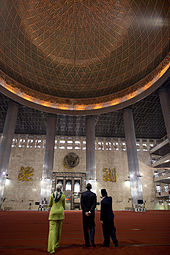
Under most interpretations of sharia, non-Muslims may be allowed into mosques, as long as they do not sleep or eat there. A dissenting opinion is presented by followers of the Maliki school of Islamic jurisprudence, who argue that non-Muslims may not be allowed into mosques under any circumstances.
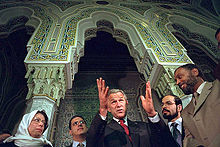
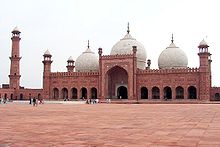
The Quran addresses the subject of non-Muslims, and particularly polytheists, in mosques in two verses in its ninth chapter, Sura At-Tawba. The seventeenth verse of the chapter prohibits those who join gods with Allah — polytheists — from entering mosques:
It is not for such as join gods with Allah, to visit or maintain the mosques of Allah while they witness against their own souls to infidelity. The works of such bear no fruit: In Fire shall they dwell.—Quran, Sura 9 (At-Tawba), ayah 17
The twenty-eighth verse of the same chapter is more specific as it only considers polytheists in the Sacred Mosque, the Masjid al-Haram in Mecca:
O ye who believe! Truly the Pagans are unclean; so let them not, after this year of theirs, approach the Sacred Mosque. And if ye fear poverty, soon will Allah enrich you, if He wills, out of His bounty, for Allah is All-knowing, All-wise.—Quran, Sura 9 (At-Tawba), ayah 28
According to Ahmad ibn Hanbal, these verses were followed to the letter at the times of Muhammad, when Jews and Christians, considered monotheists, were still allowed to the Masjid al-Haram. However, the Umayyad caliph Umar II later forbade non-Muslims from entering mosques, and his ruling remains in practice in present day Saudi Arabia. Today, the decision on whether non-Muslims should be allowed to enter mosques varies. With few exceptions, mosques in the Arabian Peninsula as well as Morocco do not allow entry to non-Muslims. For example, the Hassan II Mosque in Casablanca is one of only two mosques in Morocco currently open to non-Muslims.
However, there are also many other places in the west as well as the Islamic world where non-Muslims are welcome to enter mosques. Most mosques in the United States, for example, report receiving non-Muslim visitors every month. Many mosques throughout the United States welcome non-Muslims as a sign of openness to the rest of the community as well as to encourage conversions to Islam.
In modern-day Saudi Arabia, the Grand Mosque and all of Mecca are open only to Muslims. Likewise, the Al-Masjid al-Nabawi and the city of Medina that surrounds it are also off-limits to those who do not practice Islam. For mosques in other areas, it has most commonly been taken that non-Muslims may only enter mosques if granted permission to do so by Muslims and if they have a legitimate reason. All entrants regardless of religious affiliation are expected to respect the rules and decorum for mosques.
In modern Turkey non-Muslim tourists are allowed to enter any mosque, but there are some strict rules. Visiting a mosque is allowed only between prayers; visitors are required to wear long trousers and not to wear shoes, women must cover their heads; visitors are not allowed to interrupt praying Muslims, especially by taking photos of them; no loud talk is allowed; and no references to other religions are allowed (no crosses on necklaces, no cross gestures etc.) Similar rules apply to mosques in Malaysia, where larger mosques that are also tourist attractions (such as the Masjid Negara) provide robes and headscarves for visitors who are deemed inappropriately attired.
In certain times and places, non-Muslims were expected to behave a certain way in the vicinity of a mosque: in some Moroccan cities, Jews were required to remove their shoes when passing by a mosque; in 18th century Egypt, Jews and Christians had to dismount before several mosques in veneration of their sanctity.
